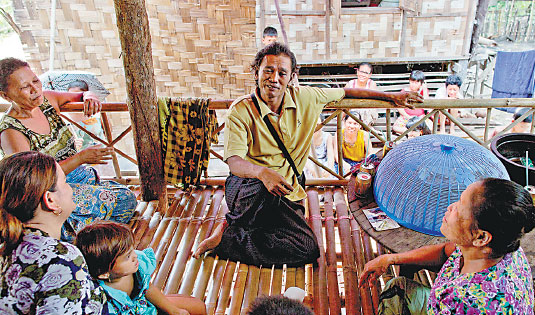Slave's tale exposes fishing trade misery
Investigation frees 800 from brutal industry that supplies outlets in US, Europe and Japan
The last time Myanmar slave Myint Naing asked to go home, he was beaten almost to death. But after being gone eight years and forced to work on a boat in Indonesia, he was willing to risk everything to see his mother again.
So he threw himself on the ground and begged for freedom. Instead, the captain chained him up for three days without food or water.
Myint is one of more than 800 current and former slaves rescued or repatriated after a yearlong Associated Press investigation into labor abuses in Southeast Asia's fishing industry.
Thailand's booming seafood business runs on an estimated 200,000 migrant workers, many of them forced onto boats after being tricked, kidnapped or sold.
It's a brutal trade that has operated for decades, with companies relying on slaves to supply fish to the United States, Europe and Japan to outlets including Wal-Mart, Sysco and Kroger, and pet food brands such as Fancy Feast, Meow Mix and Iams. The companies have all said they strongly condemn labor abuse and are taking steps to prevent it.
Myint's story is strikingly similar to accounts given by many of the more than 330 current and former slaves from Myanmar, Cambodia, Laos and Thailand interviewed in person or in writing.
In 1993, a broker visited Myint's village in southern Myanmar with promises of jobs in Thailand. Myint was only 18 years old, but his family was desperate for money.
A month later, Myint found himself at sea. He spent weeks at a time living only on rice and the parts of the catch no one else would eat.
During the busiest times, the men worked up to 24 hours a day. There was no medicine, and they were forced to drink boiled seawater. Anyone who took a break or fell ill was hit by the captain. Fishermen said that workers on some boats were killed if they slowed down, while others flung themselves overboard.
Myint was paid only $10 a month, and sometimes not at all. By 1996, after three years, he'd had enough. He asked for the first time to go home and his skull was cracked.
He ran away and an Indonesian family offered him food and shelter for work on their farm. For five years, he lived this simple life. But in 2001, he heard one captain was offering to take fishermen back home if they agreed to work. So, eight years after he first arrived in Indonesia, he returned to the sea.
After nine months, Myint's captain told the crew he was abandoning them to go back to Thailand alone. The Burmese slave once again pleaded to go home. That was when he was chained to the boat.
Searching desperately, he found a small piece of metal to pick the lock. He dove into the black water after midnight and swam to shore. Myint hid alone in the jungle in Tual. He had suffered what appeared to be a stroke, leaving his right arm partly paralyzed.
In 2011, the solitude became too much. Myint moved to the island of Dobo, where he heard there was a small community of former Burmese slaves. Then one day in April, officials took Myint back to Tual - the island where he was once enslaved - to join hundreds of other free men.
After 22 years in Indonesia, Myint, now 40, was suddenly making his way to his small village. Then he saw his mother, running toward him. He howled and fell to the ground. He was finally free to see the face from his dreams.
|
Former slave fisherman Myint Naing speaks with relatives and neighbors in Mon State, Myanmar. Myint is among hundreds of former slaves who returned to Myanmar following an Associated Press investigation into the use of forced labor in Southeast Asia's seafood industry. Gemunu Amarasinghe / AP |
(China Daily 07/02/2015 page10)















